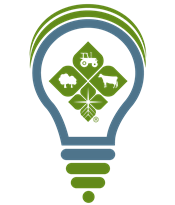September 10, 2024
The Role of Artificial Intelligence in Agriculture

Artificial Intelligence (AI) — or the ability of computers to process large amounts of data to make predictions or decisions — has been around for decades. So why the sudden hype around AI? “The biggest change is significant improvement in processing power that can turn raw data into solutions much faster,” noted Aimpoint Research Senior Analyst Chimdi Chekwa.
Erin Rodger, Senior Manager of the Office of Marketing and Communications at Cornell University’s College of Agriculture and Life Sciences (CALS) also notes, “Digital solutions, including AI, will help enhance sustainability and resilience in agrifood systems. AI is truly the next frontier, however, as it will offer producers ultra-targeted solutions in crop monitoring, yield prediction, pest management and more.”
The Integration of AI
A recent news story reported on a dairy farm that installed cameras throughout its barns to monitor activity, but nobody had time to review all the data the cameras were capturing. Enter an AI solution that reviews that footage and reports on trends and activity to alert the farmer to any anomalies. Now, the data from the existing technology isn’t going to waste but is actually generating actionable information and a return on investment.
In his book, A Smarter Farm, Jack Uldrich states AGI (or artificial general intelligence – a higher level of AI) will take automation to the next level, delivering on the promise of precision agriculture. In other words, while the technology may already exist, the addition of AI is enabling producers to optimize the potential of those tools — as was the case with the dairy producer.
Two AI solutions being integrated into farming technologies are precision agriculture and predictive analytics. According to the International Society of Precision Agriculture (ISPA), “Precision agriculture is a management strategy that takes account of temporal and spatial variability to improve sustainability of agricultural production.”
According to IBM, predictive analytics uses historical data combined with data mining, statistical modeling and machine learning to predict future outcomes.
Aimpoint Research Intelligence Analyst Abby Greiman simplified this differentiation: “precision agriculture is the equipment or ‘hardware,’ and predictive analytics is the ‘software’ that informs the hardware.” Following are some ways these AI solutions are optimizing current agricultural practices.
Environment Monitoring and Sustainability
In agriculture, cameras, sensors, satellites and drones are being used to collect data on soil composition, moisture levels and temperature. Analyzing this data allows farmers to optimize resource use by reducing inputs and improving crop yields. Coupling that data with predictive analytics enables producers to predict yields and identify disease and pest risks.
We spoke with Maxwell Torrey of Torrey Farms in Western New York, who said the potential cost savings were a big factor in their recent purchase of two laser weeders earlier this year. “With the increasing cost of labor in New York State coupled with overtime, we hope to cut back on labor expense,” he said. “But there is also the sustainability component. We can use less herbicides, which saves on input costs while hopefully resulting in higher yields and higher returns.”
These technologies are not limited to agriculture. In forestry, drones are collecting data on tree species, health and size, allowing foresters to create detailed digital maps that allows them to hyper-target harvests, promoting sustainable management and minimizing waste.
Similar technologies are being deployed in commercial fishing. Sonar systems, smart buoys, satellite imagery and underwater drones are assessing fish populations, mapping migration patterns, and monitoring habitats. In many cases, these devices can travel to depths never accessed by humans. This insight into fish behavior reduces the guesswork of determining optimal fishing grounds, which increases the catch and minimizes fuel consumption.
Livestock Monitoring
In recent years, ear tags, neck bands and chips placed under the skin have helped monitor animal health and enable robotic milkers. Now more advanced solutions, such as smart cameras or sensors are being used to monitor dairy cattle health, including how much they are eating, if they are sick, how much milk they produce, and can even predict when they will calve.
Robotics
While automatic milking systems have been around for decades, there are now automated systems to manage barn and greenhouse climates. And in forestry and the green industry, robots are even planting seedlings.
On the rise are robotics that integrate precision agriculture techniques to weed, prune, harvest and apply fertilizers. While robotics are already automating processes, layering in AI solutions like precision agriculture and predictive analytics will advance these tools by learning, adapting and operating with minimal human intervention
These are only some of the areas AI integration can benefit agricultural producers. Read more about technological opportunities in the 2024 Summer Financial Partner here.
Read the Summer Financial Partner




